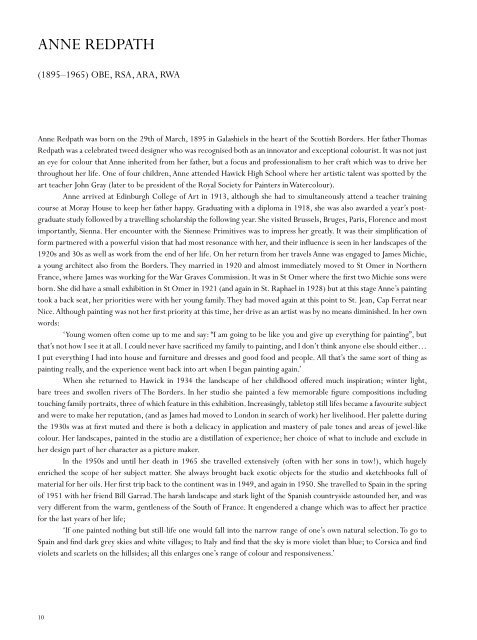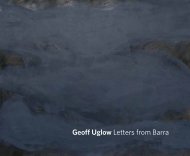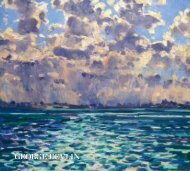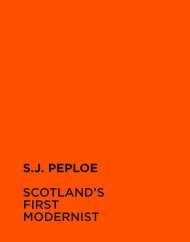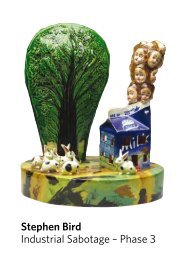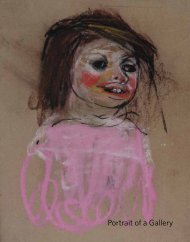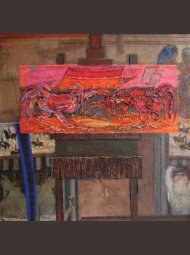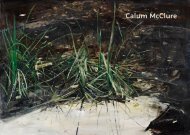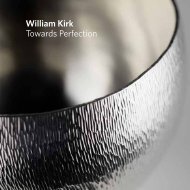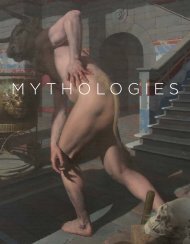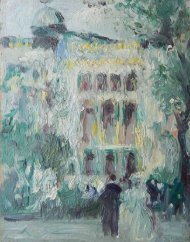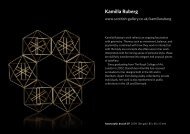Download a PDF of the exhibition catalogue - The Scottish Gallery
Download a PDF of the exhibition catalogue - The Scottish Gallery
Download a PDF of the exhibition catalogue - The Scottish Gallery
You also want an ePaper? Increase the reach of your titles
YUMPU automatically turns print PDFs into web optimized ePapers that Google loves.
anne redpath<br />
(1895–1965) OBE, RSA, ARA, RWA<br />
Anne Redpath was born on <strong>the</strong> 29th <strong>of</strong> March, 1895 in Galashiels in <strong>the</strong> heart <strong>of</strong> <strong>the</strong> <strong>Scottish</strong> Borders. Her fa<strong>the</strong>r Thomas<br />
Redpath was a celebrated tweed designer who was recognised both as an innovator and exceptional colourist. It was not just<br />
an eye for colour that Anne inherited from her fa<strong>the</strong>r, but a focus and pr<strong>of</strong>essionalism to her craft which was to drive her<br />
throughout her life. One <strong>of</strong> four children, Anne attended Hawick High School where her artistic talent was spotted by <strong>the</strong><br />
art teacher John Gray (later to be president <strong>of</strong> <strong>the</strong> Royal Society for Painters in Watercolour).<br />
Anne arrived at Edinburgh College <strong>of</strong> Art in 1913, although she had to simultaneously attend a teacher training<br />
course at Moray House to keep her fa<strong>the</strong>r happy. Graduating with a diploma in 1918, she was also awarded a year’s postgraduate<br />
study followed by a travelling scholarship <strong>the</strong> following year. She visited Brussels, Bruges, Paris, Florence and most<br />
importantly, Sienna. Her encounter with <strong>the</strong> Siennese Primitives was to impress her greatly. It was <strong>the</strong>ir simplification <strong>of</strong><br />
form partnered with a powerful vision that had most resonance with her, and <strong>the</strong>ir influence is seen in her landscapes <strong>of</strong> <strong>the</strong><br />
1920s and 30s as well as work from <strong>the</strong> end <strong>of</strong> her life. On her return from her travels Anne was engaged to James Michie,<br />
a young architect also from <strong>the</strong> Borders. <strong>The</strong>y married in 1920 and almost immediately moved to St Omer in Nor<strong>the</strong>rn<br />
France, where James was working for <strong>the</strong> War Graves Commission. It was in St Omer where <strong>the</strong> first two Michie sons were<br />
born. She did have a small <strong>exhibition</strong> in St Omer in 1921 (and again in St. Raphael in 1928) but at this stage Anne’s painting<br />
took a back seat, her priorities were with her young family. <strong>The</strong>y had moved again at this point to St. Jean, Cap Ferrat near<br />
Nice. Although painting was not her first priority at this time, her drive as an artist was by no means diminished. In her own<br />
words:<br />
‘Young women <strong>of</strong>ten come up to me and say: “I am going to be like you and give up everything for painting”, but<br />
that’s not how I see it at all. I could never have sacrificed my family to painting, and I don’t think anyone else should ei<strong>the</strong>r…<br />
I put everything I had into house and furniture and dresses and good food and people. All that’s <strong>the</strong> same sort <strong>of</strong> thing as<br />
painting really, and <strong>the</strong> experience went back into art when I began painting again.’<br />
When she returned to Hawick in 1934 <strong>the</strong> landscape <strong>of</strong> her childhood <strong>of</strong>fered much inspiration; winter light,<br />
bare trees and swollen rivers <strong>of</strong> <strong>The</strong> Borders. In her studio she painted a few memorable figure compositions including<br />
touching family portraits, three <strong>of</strong> which feature in this <strong>exhibition</strong>. Increasingly, tabletop still lifes became a favourite subject<br />
and were to make her reputation, (and as James had moved to London in search <strong>of</strong> work) her livelihood. Her palette during<br />
<strong>the</strong> 1930s was at first muted and <strong>the</strong>re is both a delicacy in application and mastery <strong>of</strong> pale tones and areas <strong>of</strong> jewel-like<br />
colour. Her landscapes, painted in <strong>the</strong> studio are a distillation <strong>of</strong> experience; her choice <strong>of</strong> what to include and exclude in<br />
her design part <strong>of</strong> her character as a picture maker.<br />
In <strong>the</strong> 1950s and until her death in 1965 she travelled extensively (<strong>of</strong>ten with her sons in tow!), which hugely<br />
enriched <strong>the</strong> scope <strong>of</strong> her subject matter. She always brought back exotic objects for <strong>the</strong> studio and sketchbooks full <strong>of</strong><br />
material for her oils. Her first trip back to <strong>the</strong> continent was in 1949, and again in 1950. She travelled to Spain in <strong>the</strong> spring<br />
<strong>of</strong> 1951 with her friend Bill Garrad. <strong>The</strong> harsh landscape and stark light <strong>of</strong> <strong>the</strong> Spanish countryside astounded her, and was<br />
very different from <strong>the</strong> warm, gentleness <strong>of</strong> <strong>the</strong> South <strong>of</strong> France. It engendered a change which was to affect her practice<br />
for <strong>the</strong> last years <strong>of</strong> her life;<br />
‘If one painted nothing but still-life one would fall into <strong>the</strong> narrow range <strong>of</strong> one’s own natural selection. To go to<br />
Spain and find dark grey skies and white villages; to Italy and find that <strong>the</strong> sky is more violet than blue; to Corsica and find<br />
violets and scarlets on <strong>the</strong> hillsides; all this enlarges one’s range <strong>of</strong> colour and responsiveness.’<br />
10


